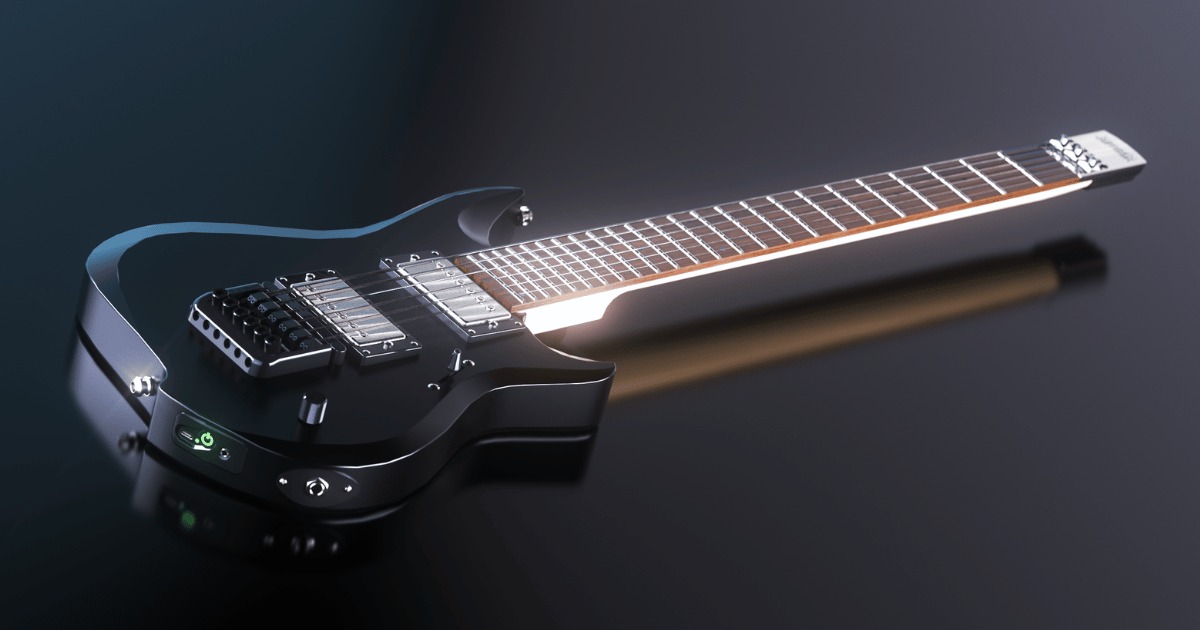Jamstik Studio Review: MIDI guitar hero or hype?
All images from Jamstik unless stated otherwise
Jamstik want to free guitarists from their analogue trappings and welcome them to the digital world of MIDI and VSTs: Can they do it?
Digital music production has broadened the scope of creation in infinite directions. The possibility of sounds, manipulation, and arrangement are beyond what we ever could have imagined just decades ago.
Entire recording studio’s worth of power can now be packed into a single program on your computer. The most comprehensive library of instruments is now a single click away, allowing you to play with traditional instruments from around the world as well as astonishing new sounds not even dreamed of before modular synthesis.
This is all great for those who know how to play keys or are willing to paint in notes robotically with their mouse. But what about those of us who play with strings? We’ve long been stuck between two worlds, strumming our instruments and converting ideas with a mouse scroll or the vaguely transferable understanding of notation to a MIDI keyboard.
That’s where the Jamstik comes in.
This powerful controller is a guitar. It has 6 strings, a familiar fretboard, and plays like your average electric guitar – it even features a jack to plug into your amps. But there’s a bonus! It features a pickup that transfers your playing into MIDI notes, empowering you with full MIDI control from your chords, picks, and shreds.
Finally, the guitar players of the world (and bass and other string players too!) can use their finger skills in the immense world of digital music. In theory, this means playing an unlimited array of instruments and sounds, tweaking the output of your guitar with limitless possibilities, and recording your notes straight into your music software.
But, is it actually any good? Let’s find out!
Unboxing the Jamstik and first impressions
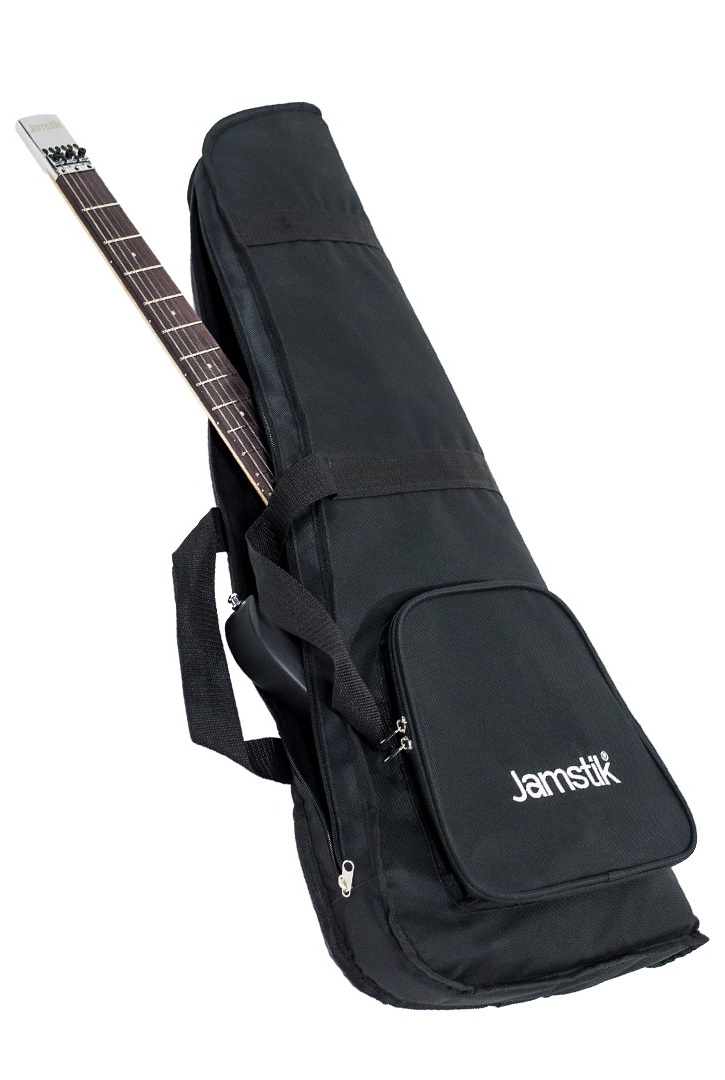
One of the first things that strikes any regular guitar player is the size of the Jamstik Studio. It’s a roughly ⅔ size guitar that may feel junior if you’re used to full-size guitars. It has been designed with portability in mind, being compact but also surprisingly light considering what it is packing. It comes with a nifty carry case to take it with you, featuring all the tools you’ll need to tweak the instrument with and then some.
The space conscious design just so happens to fit the studio purpose really nicely too. You can stow it in the corner of your home studio and easily grab it out to lay down some tracks. If you’d rather stay on familiar ground, there are full-size Jamstik guitars on offer. Alternatively, the super nifty flagship Jamstik offers the ultimate combo of lots of potential in a tiny package that is essentially a standalone fretboard.
Once you start playing you will immediately feel at home. A 24-fret, maple neckboard feels just right, filling you with immediate confidence to get stuck in with what makes this guitar so exciting: Playing MIDI with a guitar! It’s not the greatest electric guitar playing experience but it’s primary purpose wasn’t to be the perfect electric guitar.
You may feel overwhelmed by features at first, but settle in as it’s all rather straightforward. You have a simple plug and play via USB for attaching to computers. This is also how you charge it. Be aware, you’ll want to plug it in before turning it on – whilst it comes with a bit of charge my computer wouldn’t recognise the Jamstik until I had plugged it in and then turned it on afterwards.
For those who’ve had enough of the tangle of wires that fills every home studio, well Jamstik have you covered there too. The mobile app allows you to connect the Jamstik via bluetooth, loading up virtual instruments which you can play on the go through headphones. No, we’re not joking – you really can! Be aware you’ll connect your headphones to your device, there’s no onboard audio sadly.
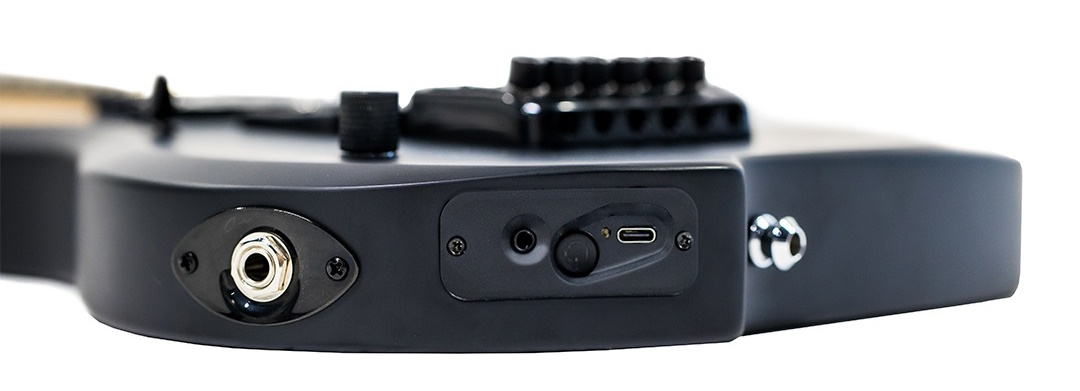
On first touch, it’s obviously not going to play like the American Strat you saved up for – but it feels natural and smooth enough to enjoy playing. It is certainly playable enough to satisfyingly use for playing MIDI instruments.
So, I guess we should get to playing it then, hey?
Playing the Jamstik
You have three primary options for playing the Jamstik. First, you can use a traditional jack to play it through an amp or plug it into an interface for the classic electric guitar sound. Whilst the Jamstik hasn’t been designed to act as a great electric guitar it does bolster its purpose as the perfect studio guitar giving you the option to plug in and shred out a solo straight into your interface.
But of course, we’re here to discuss its MIDI power. The second and primary use the Jamstik has been created for is plugging into your PC and making use of its MIDI pickup to play virtual instruments and record MIDI using your software of choice.
Download Jamstik’s Creator app to unlock its powerhouse of potential. From the app you have a huge library of sounds to explore from funky keyboard sounds to cinematic bass explosions and lots more in between.
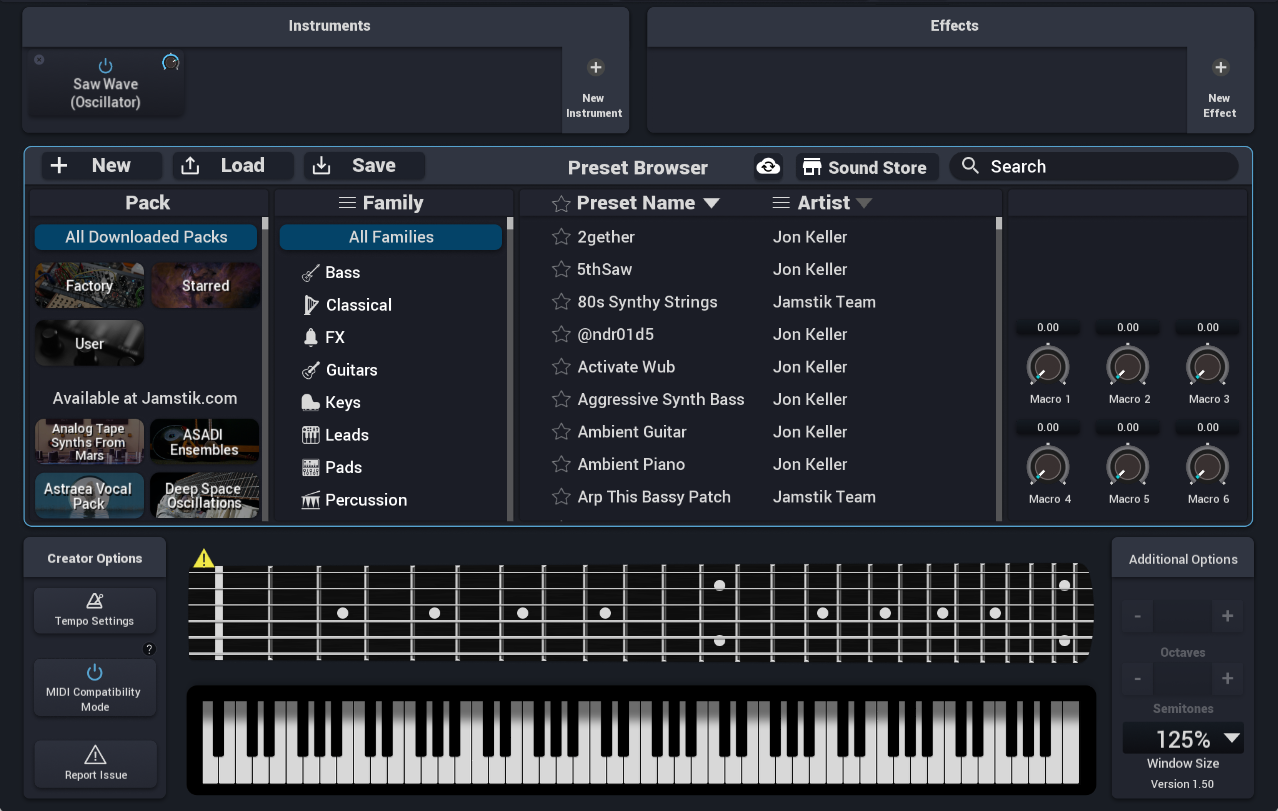
In the app you can tweak the settings to suit how you want to control your virtual instruments. You can choose your MIDI mode; picking between single channel, multi-channel, and the recommended MIDI Polyphonic Expression (MPE) which allows for picking up the individual note and velocity of each string. This is the mode that empowers the Jamstik with authentic guitar playing that translates to MIDI controlled instruments.
If you’re playing a virtual instrument that plays best with accurate notes then turn off pitch bend for more consistent single notes. But wait… There’s a pitch bend function? That’s right! The Jamstik doesn’t simply allow you to turn the way you play chords and notes into MIDI, but also converts the techniques of guitar to MIDI. This means you can pitch bend, hammer on and off, and slide between notes.
How does this work you might wonder? Pretty well for the most part. You will however quickly notice that you need to play accurately on the Jamstik. Whilst there is a lot of room for forgiveness when playing guitar traditionally – in fact, sloppiness can sometimes enhance the sound ey Kurt? – that’s not the case here.
The guitar must be tuned near perfect so that it can correctly match the notes. It features locking nuts to help keep this in check but you will still benefit from tuning each time you use it. There is a little magnetic tuning key that slots into the bridge and I don’t know why but I love that; it’s so satisfying.

You can use alternate tunings but you need to make sure you’re inputting it into the Creator app so it knows how to convert the signals from each string. The MIDI pickup needs accurate notes so that it can convert it with precise pitch. That means that things like percussive scratching aren’t going to work here – but it wouldn’t on a keyboard either!
This can be a learning curve for the average guitarist but something you will get used to quickly to create a better sound from the Jamstik. Ultimately, it’s encouraging you to play with more clarity and precision which isn’t necessarily a bad thing; it might just be jarring for guitarists who are used to full expression converting their technique to this instrument. But, that’s the thing to remember: You’re not playing a guitar through a pedal, you’re utilising a signal converter when you play the MIDI.
A huge benefit of the Jamstik is that it has incredibly low latency. It uses onboard processors to take some of the demands away from your computer and empowers a super fast signal, so when you are playing along or recording you won’t be alienated by any delay.
Jamstik Mobile: On the go guitar MIDI
The third way to use this piece of kit is with your mobile devices; smartphones and tablets. The Jamstik Creator app empowers you with the functionality of the desktop app and a limited selection of sounds to play with right there. This is fantastic for a fun jamming session on the go and again the latency is surprisingly good. As with Jamstik Creator for the PC, the app also gives you control over the Jamstik’s functionality including bending, octaves, and a virtual capo.
The instruments included in the app are severely limited compared to what’s on offer on the PC program. There are quite a few to choose from but they are a strange selection, largely made up of big synth-y basses and the weirder instrument offerings with very little in the way of a regular instrument sound to play with. I think its a shame as whilst I was impressed with how well the app works on mobile, the instruments didn’t keep me playing there for long.
You can record with the Jamstik on the go, outside of the Creator app. Jamstik works with a number of music apps allowing you to play other (better) virtual instruments on the go and even record. For Android, you can use BandLab and FL Studio Mobile. On iOS you can connect your Jamstik to Logic Pro, Garageband, and GeoShred.
The Bluetooth connection is surprisingly lag-free, though there is a slight, expected jump. The Jamstik’s internals really come in handy here, saving your phone from doing the heavy lifting – particularly if you haven’t got a powerful device.
The downside of using it whilst on the go is that it relies on the battery. Whilst boasting 8 hours of usage when fully charged, I found that it took a bizarrely long time to charge. Admittedly, we used a USB connection to the computer to charge, but it made it to just 70% after 24 hours. I can’t speak to whether it performs better when plugged into the mains via a USB adapter but I did try it on a number of computers to the same result. They tout USB charging as a primary method so perhaps there was an issue with our model but it was frustrating nonetheless.
Is the Jamstik any good?
If you’re looking to play like Hendrix then you’re going to want to look elsewhere. The Jamstik – as a guitar – is not the most satisfying to play. The action is reasonable to play with but not buttery, the fretboard is fine but not as smooth and responsive as one of the classics, and with just a volume pot there is little customizability in your output.
But you’re not buying it as a guitar – you’re buying it for its MIDI pickup. If you’re a guitarist looking to unlock a superior level of playing with digital instruments then you probably won’t find better than this – not for the price. It is not perfect and it takes time to get used to playing cleanly enough that you get a consistent response from your MIDI powered sounds, but it absolutely works.
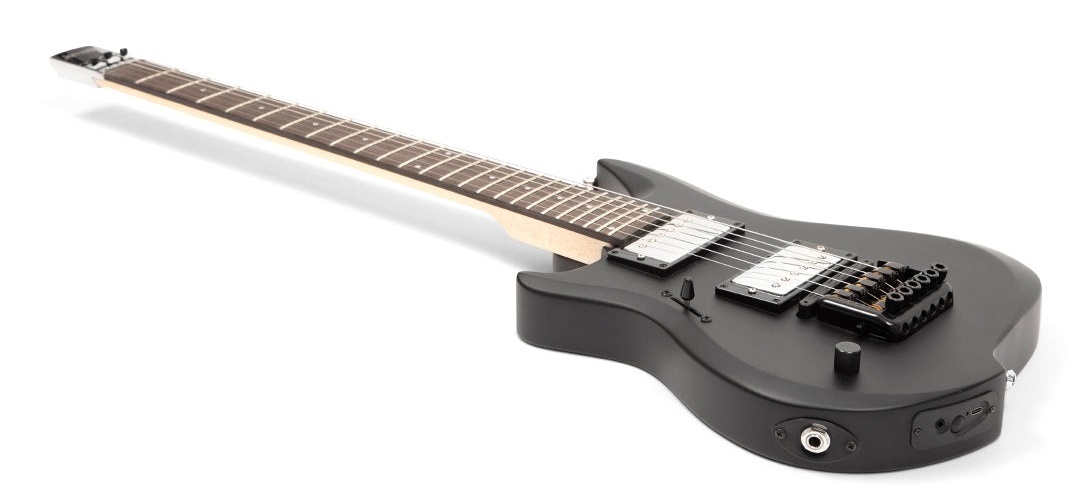
It is not the most superior way to input MIDI notation, particularly when it comes to chords. Keys are going to be superior, but the Jamstik succeeds in its job of empowering the guitar player with a level of that freedom that MIDI keyboards offer to those who can play the keys.
Chords will convert and play out of your virtual instrument; your guitar solos will convert distortion powered shredding into a trumpet going blitz; you can use your knowledge of notation to play out and record basslines, melodies, and more using the guitar. What does set it apart from MIDI keyboards is natural expression in pitch bending and the way you use velocity by strumming and picking.
Using a MIDI pickup is both its benefit and crux. It is what allows the flexibility of a guitar with pitch bending and traditional playing, but it is where you will encounter problems if you do. It will at times get confused over notes and particularly any percussive noises you might make – like a muted strum in between chords – can negatively impact your outcome..
As mentioned before you need to be accurate and clean with your playing to best make use of it, but you will still encounter the odd glitch. It reacts generally well to bending and hammering on/pulling off if you get the notes accurate. It purports to work with palm muting but I didn’t find it gave good results here.
It reacts well to velocity, allowing you to build up softly and strum hard for an explosion of sound. This has fantastic results on certain virtual instruments which offer an explosive sound when strummed hard that is satisfyingly offset by gentler playing. This was a shining moment of playing a “guitar” but exploring the dynamics of a completely unique sound. However, there is a learning curve with each virtual instrument you load up as to how intensely the velocity may vary. Some instruments I noticed played very quietly unless you gave it a thrashing strum whilst others boom from the get-go.
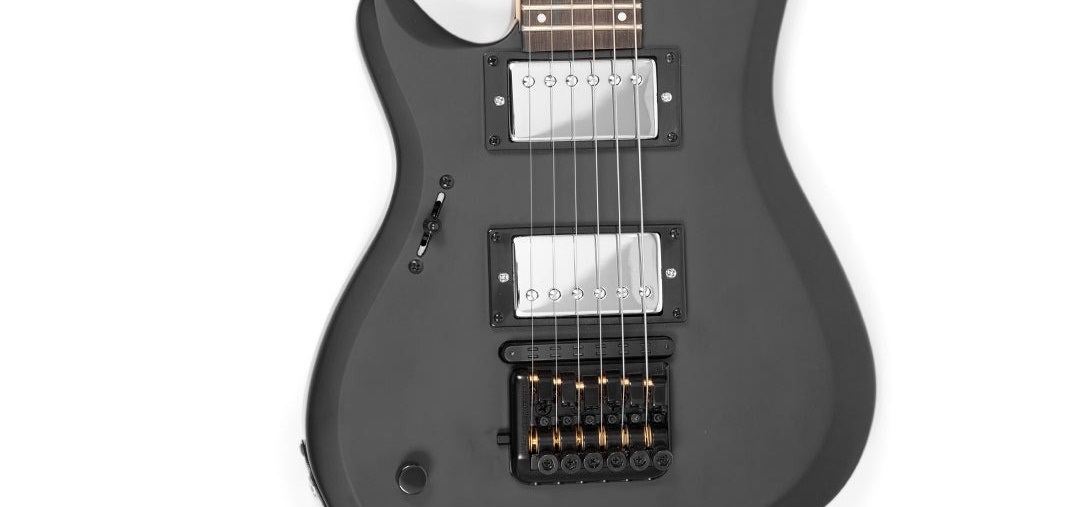
The largest problem I had was it regularly mistranslating a certain note. Playing the 2nd fret F# on the low E string would often result in the MIDI outputting a G. The tuning was as correct as could be and I could hear the correct note on the guitar string, so I have no idea why it was doing that. This was pretty game breaking when trying to record a chord sequence that included F# minor as the root was out of tune 50% of the time.
Jamstik in Summary
As a guitarist, the power to pick up an axe and play any virtual instrument using the same technique that I have learnt to play music with all my life is empowering. There is something incredibly satisfying about finally being able to play a grand piano with eclecticism after the instrument has always been inaccessible to my untrained fingers. It is really fun to just explore how the guitar pieces you know sound with wildly different sounds like an organ, a supersaw synth, or electro strings.
And that’s what I found it best as: A fun, jamming instrument. Which perhaps explains its namesake. It does connect very easily into DAWs and it will work with your instruments to a satisfying degree, but even as a guitarist I don’t know if I would choose it as my primary method for recording MIDI into projects.
I found that the result was simply too inconsistent for me to comfortably use it as the sole controller in a digital arrangement. It shines at expression and if you can play accurately enough for a consistent translation then it’s a fascinating way to add some clean MIDI licks or solos. It’s also a fantastically satisfying way to play huge basslines.
Chords are a tough one. Sometimes they sound fantastic and you can’t deny it is impressive that it can convert your strummed chords into MIDI outputs for a virtual instrument, particularly with velocity considerations. However, as I mentioned above there are downsides to this like the percussive elements of strumming sometimes confusing the signal or a bum note translation throwing the whole chord into discordance.
For that reason, I would find it hard to favour the Jamstik over a decent MIDI keyboard in terms of laying down a solid track. But as a fun piece of kit that enables experimentation and empowers guitarists in the digital world of music – it is very much worth your consideration.
The Jamstik Studio is available in a variety of colours for $799.99.
Want to find out more about the Jamstik?
Stay tuned for more content and videos from us as we get more hands on with the Jamstik including a video demonstration review and how it squares up for trying to record a whole song. We’ll be posting more on Jamstik here on the RouteNote Blog and on the RouteNote YouTube channel soon.
